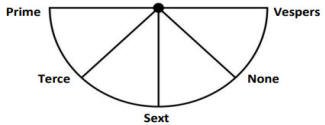"In
the years following St. Patrick’s conversion of the people of Ireland to
Christianity, monastic settlements, both large and small, were established
throughout the land. The early Irish Christian monks established their
communities well away from the towns and villages so that they could follow
their monastic rules and live contemplative lives in isolation. In order to
properly regulate their times of group prayer and, to a lesser extent, mark the
passage of time for secular purposes, each monastery would have had a sundial
to mark the appropriate prayer periods.These stone sundials were always set
into the ground in open areas, within the boundaries of the monasteries, well
clear of all shadows, with their faces orientated due south. The iron or timber
gnomon was let into a horizontal hole in the stone, from which the hour lines
radiated, casting a shadow along the lines in accordance with the time of day,
and indicating noon by the vertical line running down from the base of the
gnomon."
From: The Ancient Sundials of Ireland, Mario Arnaldi, The British
Sundial Society, 2000.
The temporal lines on these sundials
were designed not to measure the passing hours but to mark the times
when canonical prayers should be said
viz Dawn(Prime), Mid-morning(Terce), Mid-day(Sext), Mid-afternoon(None)
and Evening(Vespers).

Only eleven of these ancient sundials have
survived in Ireland. Another two have been 'lost' in the recent past. Two
have survived in Wales and a fragment of another is to be found on the Isle of
Man.
If you
know the location of a sundial in Ireland (NOT a mass produced
DIY Store garden ornament) please email it to me
(Click here to email
M.J.Harley) - a
member of British Sundial Society 





